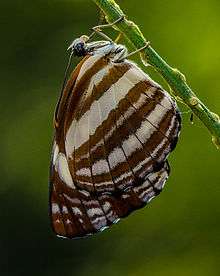Neptis nata
Neptis nata, the clear sailer or dirty sailer,[1] is a species of nymphalid butterfly found in south and southeast Asia.[2][1][3][4]
| Neptis nata | |
|---|---|
 | |
| Scientific classification | |
| Kingdom: | |
| Phylum: | |
| Class: | |
| Order: | |
| Family: | Nymphalidae |
| Genus: | |
| Species: | N. nata |
| Binomial name | |
| Neptis nata Moore, 1857 | |
Description
Dry-season brood: Male and female. Upperside deep purpurescent-black; markings bluish-white, very prominent, and with sharply-defined edges; cilia alternated with white. Forewing with the cell-streak broadly truncate at end, the broad discocellular spot beyond elongated to an acute point; discal curved series of spots of moderate size, the subapical rather elongated and oval, the lower four disposed linearly-oblique, the upper one small, oval, and placed very near the submarginal lunules, the two lowest smallest and narrow, the second being broad; a submarginal row of small white lunular spots, which are narrowest in the female, an inner submarginal slender sinuous obscure pale line, and a marginal obscure lunular line. Hindwing with a somewhat narrow inner-discal band, which ends at the upper subcostal vein, and a narrower outer-discal macular band; a medial-discal obscure pale slender lunular line, and a marginal even line; base of costa in male broadly glossy silvery-grey, and with a duller grey medially disposed patch of scales from the costal vein to below base of the radial. Underside dusky olivescent purplish-brown; markings as above, prominent, all bluish-white, except the inner and outer marginal line on forewing, and the medial disoal and marginal line on the hindwing, as well as its two basal streaks, which are lilacine-grey. Body and palpi above black, thorax iridescent; abdomen above with a basal slight bluish-grey band; palpi and thorax beneath, forelegs, middle and hind femora bluish-grey; abdomen beneath, middle and hind tibiae and tarsi pale ochreous-brown. Wet-season hrood: Upperside with all the markings somewhat narrower; underside with the ground-colour reddish-brown; markings as above, except that on the hindwing the medial-discal white band extends anteriorly above the upper subcostal vein.
References
- "Neptis Fabricius, 1807" at Markku Savela's Lepidoptera and Some Other Life Forms
- R.K., Varshney; Smetacek, Peter (2015). A Synoptic Catalogue of the Butterflies of India. New Delhi: Butterfly Research Centre, Bhimtal & Indinov Publishing, New Delhi. p. 192. doi:10.13140/RG.2.1.3966.2164. ISBN 978-81-929826-4-9.
-

-
